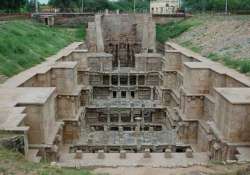Gujarat's Rani-ki-Vav recognised as UNESCO World Heritage Site
New Delhi: ‘Rani-ki-Vav', an 11th century stepwell in Gujarat, has been approved as a World Heritage Site by UNESCO which described it as “exceptional example of technological development” in utilising ground water resources.“Stepwell Rani-ki-Vav has

New Delhi: ‘Rani-ki-Vav', an 11th century stepwell in Gujarat, has been approved as a World Heritage Site by UNESCO which described it as “exceptional example of technological development” in utilising ground water resources.
“Stepwell Rani-ki-Vav has been approved for inscription on the World Heritage list. The recognition was granted by the UNESCO at the World Heritage Committee Session currently on at Doha, Qatar,” the Culture Ministry said here today.
“UNESCO has recognised this masterpiece as an exceptional example of technological development in utilising ground water resources in a single component, water management system and it illustrates the exceptional capacity to break large spaces into smaller volumes following ideal aesthetic proportions,” it said in a statement.
Rani-ki-Vav, a unique type of Indian subterranean architectural structure, marks the zenith in the evolution of stepwells in India, it said, adding that it is a particularly large and complex example of a stepwell with seven storeys of ornamented panels of sculptures and relief representing the height of the Maru-Gurjara style.
Following the flooding and disappearance of the Saraswati River due to geotectonic changes, the property was buried under layers of silt for almost seven centuries and has been preserved underneath in an exceptional state of conservation by the Archaeological Survey of India.
It was nominated by ASI for the World Heritage List of UNESCO in February last year.
The inscription of Rani-ki-Vav on the World Heritage List as the single most example of a stepwell is a testimony to the traditional water systems of India, it said.
There are already 30 World Heritage Sites in India -- 24 Cultural sites and six Natural properties. The Gujarat's stepwell will be the 31st such site in the country.
“Stepwell Rani-ki-Vav has been approved for inscription on the World Heritage list. The recognition was granted by the UNESCO at the World Heritage Committee Session currently on at Doha, Qatar,” the Culture Ministry said here today.
“UNESCO has recognised this masterpiece as an exceptional example of technological development in utilising ground water resources in a single component, water management system and it illustrates the exceptional capacity to break large spaces into smaller volumes following ideal aesthetic proportions,” it said in a statement.
Rani-ki-Vav, a unique type of Indian subterranean architectural structure, marks the zenith in the evolution of stepwells in India, it said, adding that it is a particularly large and complex example of a stepwell with seven storeys of ornamented panels of sculptures and relief representing the height of the Maru-Gurjara style.
Following the flooding and disappearance of the Saraswati River due to geotectonic changes, the property was buried under layers of silt for almost seven centuries and has been preserved underneath in an exceptional state of conservation by the Archaeological Survey of India.
It was nominated by ASI for the World Heritage List of UNESCO in February last year.
The inscription of Rani-ki-Vav on the World Heritage List as the single most example of a stepwell is a testimony to the traditional water systems of India, it said.
There are already 30 World Heritage Sites in India -- 24 Cultural sites and six Natural properties. The Gujarat's stepwell will be the 31st such site in the country.